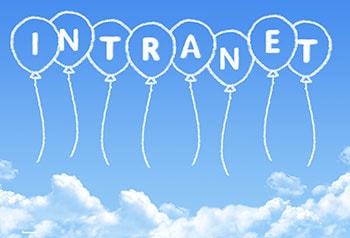Nowadays the terms intranet, extranet and portal are often used interchangeably. It can, therefore, be very confusing to work our exactly what the differences are, let alone decide which option is the best for your organization. In this article, we’ll help you to understand what the terms really mean and in what situations the technologies are best applied. You’ll then be able to make an informed choice as to the best option for you.
In a general sense intranets, extranets and portals are all online tools that will help to reduce the amount of time spent on completing everyday tasks, enhance productivity in the workplace and improve communications. Any business or industry can take advantage of the benefits that are on offer. There are, however, unique aspects to each option and so let’s look in detail at intranets, extranets and portals.
Intranets

Intranet Use
Businesses are using intranets for a variety of reasons. Sometimes it’s to deal with a particular pain point such as improving internal communications, promoting opportunities for collaboration across a disparate workforce or increasing employee engagement. Often it’s in response to a general need to make it easier to communicate and share documents within the company, to streamline day-to-day activity and to help organize people and data.
Certainly since more and more work is now being carried out away from the traditional 9 to 5, centralized office set up, the intranet has really come into its own lately. The fact that staff members can still access the intranet and utilize all the tools and features while telecommuting, working remotely or in a different office location, and while representing the company out on the road is a real boon to productivity. It’s also a very attractive proposition for those companies that want to offer workers flexibility and a better work/life balance while also maintaining company profits.
Extranets

Extranet Use
Businesses have found a variety of uses for extranets: from the university or college utilizing an extranet for the payment of fees and sharing of information with students and parents, to the car manufacturer using an extranet to enhance collaboration and communication with suppliers thereby streamlining the supply chain and saving many dollars. Extranets are also a great option for companies that need to share information backwards and forwards with clients and customers – such as a graphic design company, accountants or law firms – as it will save valuable time and resources in comparison to the more traditional media of emails or phone calls.
From a customer’s perspective an extranet offers the potential for more direct, personalized and responsive customer relationships with your business. They will be able to communicate directly with you and can have real two-way conversations. And from the point of view of business partners or suppliers, extranets allow for the easy transfer of information and data and are a great vehicle for collaboration and joint working. They will save time and will help to cut down on the email and paper trail, making both parties more efficient and effective.
Portals

Portal Use
From banks and accountants to colleges, universities and healthcare providers, even childcare centers, a great many businesses and industries are utilizing portals, particularly in response to the challenges of information management that exist in all organizations. The single-sign on and integrated nature of the portal appeal to many companies, especially those that make use of multiple systems and apps. Many portals also offer the possibility of customization and personalization for staff members. So instead of every employee accessing the full range of tools and apps that are available through the portal, they can customize it to those that are pertinent to their role or team. The ability to provide a streamlined, coherent working environment in this way is a powerful concept in today’s complex business environment.
The Best Option?
As we’ve seen, when it comes to intranets, extranets and portals there are some features that are common across the platforms, and there are others that are specific. Which option is the best one for your organization will largely depend on what your objectives are. It’s important to remember, however, that the options are not mutually exclusive. In fact, increasingly companies are utilizing software that seamlessly combines two or more of the options into one integrated digital platform. The end result is the same though: a more productive and efficient workplace.
If you would like to find out more about intranets, extranets or portals then get in touch with the expert team at MyHub for an informal discussion.







0 Comments